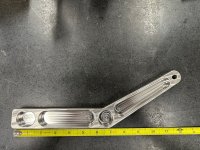rokstarr999
Aluminum
- Joined
- Feb 7, 2014
- Location
- Sonoma County, USA
303 SST / Part Blank is 1" thick x 3 x 13.
I rotated the part program approx. 30 deg to fit the part into a smaller blank as seen in the 3rd photo. Part finishes at .750" thick and is 1.375" at it's widest point. I used 2 Kurt vises and first op'ed on parallels. I machined all features leaving .230" on the bottom and then cut soft jaws for my second op flipping the part 180 deg / right to left. Second op was just taking off the .230" and radius the outside edge.
I have more than an acceptable amount of hours on this part and it finished with a bow in it. I measured the thickness all around the perimeter of the part and I'm within .002" so I'm assuming the part warped when I took the back off. I'm not sure what I should change or do different to get this thing to come out flat other than maybe not using vices. Clamp the stock down to the deck, machine all features and then slot the profile.
Thanks for looking



I rotated the part program approx. 30 deg to fit the part into a smaller blank as seen in the 3rd photo. Part finishes at .750" thick and is 1.375" at it's widest point. I used 2 Kurt vises and first op'ed on parallels. I machined all features leaving .230" on the bottom and then cut soft jaws for my second op flipping the part 180 deg / right to left. Second op was just taking off the .230" and radius the outside edge.
I have more than an acceptable amount of hours on this part and it finished with a bow in it. I measured the thickness all around the perimeter of the part and I'm within .002" so I'm assuming the part warped when I took the back off. I'm not sure what I should change or do different to get this thing to come out flat other than maybe not using vices. Clamp the stock down to the deck, machine all features and then slot the profile.
Thanks for looking




